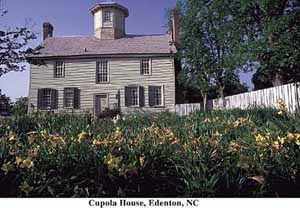Tar Heel Travels
 The
Outer Banks The
Outer Banks
A slow cruise along the coast
awes a first-time visitor
By Bill F. Hensley
In my
business, pleasant travel assignments often arise that lift the
spirits and enable me to renew a fondness for a particular area. Such
was the case when longtime friends Linda and Ben Vernon of Charlotte
said they wanted to go to the Outer Banks. An Ohio native, Linda had
never made the long trek to the coast and was anxious to explore this
famed area so rich in history and tradition.
I was happy to plan an
itinerary that would show her the highlights of our unique coast, a
rare land that is steeped in the legends and lore, the mysteries and
the memories of our nation’s founding. With my wife, Carol, the four
of us left armed with history books, maps and colorful brochures.
Our first stop was in
Washington, a charming little Beaufort County town. Life in this
picturesque waterfront town is pleasurable and revolves around water
activities that include fishing and boating.
We stayed at the Pamlico
House, an attractive antebellum mansion near the center of town. We
walked the streets and viewed the wondrous homes, the luxurious boats,
and the Estuarium. A leisurely dinner at PJ’s in midtown was
memorable.
From Washington, we drove to
Bath, which dates to 1696, and is North Carolina’s oldest town.
Again, we walked the shaded streets and visited the St. Thomas
Episcopal church (1734), the oldest church in the state, and marveled
over the stately homes that were built in the 1700s and 1800s.
Another short hop took us to
Belhaven and lunch at the renowned River Forest Manor on the Pungo
River, a known stopping place for the many fancy yachts that cruise
the intercoastal waterway. Before heading north for Edenton, we drove
through the town’s classic waterfront residential area, and toured
the interesting Belhaven Memorial Museum.
Edenton, a former capital,
has long been one of my favorite cities. It oozes with charm and a
casual walk through its downtown residential area is like a visit to
yesteryear, a nostalgic return to the 18th and 19th centuries. The
town gained notoriety in 1774 when its women staged a riotous “tea
party” to protest English taxes. Highlights were the Cupola House
and St. Paul’s Church and dinner at the town’s newest fine
restaurant, Kramer’s Garage. We spent the night at the Lords
Proprietors, one of the town’s many bed and breakfast inns.
The third day found us en
route to the Outer Banks, a spectacular drive that crossed the
massive, wind-swept Albemarle Sound. The first stop was Ft. Raleigh,
where the English first attempted to settle the New World in 1585. We
enjoyed the Elizabethan Garden, the waterside theater where the
outdoor drama “The Lost Colony” has played each summer since 1937,
depicting the saga of John White and Virginia Dare.
Before checking into the
Sanderling Inn, one of the nation’s top resorts, we stopped by the
Wright Brothers Monument and Museum. The Sanderling, our home for the
next two days, is a showplace that offers excellent food, service and
accommodations. The drive between Corolla and Duck will cause a
culture shock for those who haven’t been there in recent years.
Expecting to see sand dunes, sea oats and a few wild ponies in lonely,
desolate surroundings, today’s visitor encounters miles of million
dollar oceanfront mansions, side by side in a gaudy display of
opulence.
From Duck to Ocracoke is a
pleasant 70-mile journey through the National Seashore with the ocean
on the left, the Pamlico Sound on the right, and sand dunes all
around. We looked in on Rodanthe, Waves, Salvo, Avon and Frisco along
the way and stopped in Buxton to see the Cape Hatteras Lighthouse. We
drooled over crab cakes at the Soundside restaurant in Hatteras.
The half-hour ferry ride to
Ocracoke brought us to a remote seaside village whose main attractions
include 25 miles of deserted beaches, great fishing and watersports
and a variety of small inns, motels and restaurants. We stayed at the
Island Inn, walked to the ancient lighthouse, rode bikes, saw the
museum and the British cemetery, and circled Silver Lake.
The following day, we took
the ferry from Ocracoke to Cedar Island, a leisurely 2 1/2-hour cruise
that enabled us to have a picnic lunch in the passenger lounge and
review the material on Morehead City, Beaufort and Atlantic Beach.
Beaufort (1723) is one of
the state’s jewels, a peaceful waterfront town of vintage homes that
evokes memories of our colorful past. We enjoyed a seafood dinner at
the Sanitary Fish Market in Morehead, saw Fort Macon State Park, the
Maritime Museum and strolled through impressive neighborhoods.
The last stop was in the
dignified city of New Bern, our first capital, on the Neuse and Trent
rivers. Life is relaxed and easy in this quintessential eastern North
Carolina community that offers the incomparable and courtly Tryon
Palace and Garden among its many splendors.
Linda is now an enthusiastic
coastal North Carolina convert. “I thoroughly enjoyed seeing this
lovely part of our state,” she says. “Like many others, I have
discovered a seaside treasure.”
Return to magazine index
|
|

